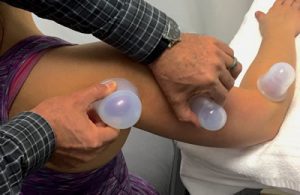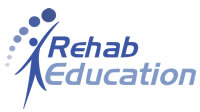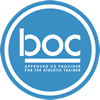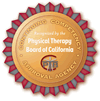Scrape, Tape, Cup & Glide: Restoring Space, Motion, & Slack for Restricted Neural Dynamics of the Upper Quarter
 The concept of restricted neural dynamics is not new, however, its impact on our patients’ daily activities and movement tolerance is often overlooked during the examination and treatment of our patients. This course integrates the basic concept of “test-treat-retest” as a foundation to manage these challenging patients.
The concept of restricted neural dynamics is not new, however, its impact on our patients’ daily activities and movement tolerance is often overlooked during the examination and treatment of our patients. This course integrates the basic concept of “test-treat-retest” as a foundation to manage these challenging patients.
The basic principle that neural tissue needs space, motion, and slack for optimal healing potential underpins all concepts covered. This upper extremity focused course features motion-based interventions consisting of:
- neural flossing
- nerve bed/nerve differential gliding
- instrument assisted soft tissue mobilization (IASTM)
- negative pressure soft tissue mobilization (cupping)
- corrective exercises
- taping
Please dress to allow access to your entire upper quarter to enhance the learning process.
During the hands-on lab sessions, the course instructor will evaluate each application for neural mobilization, IASTM, Cupping and Taping to determine 100% proficiency of all basic treatment techniques. This will be determined by direct observation and correction of any issues with techniques.
This course content is not intended for use by any participants outside the scope of their license or regulation.
You will be required to:
- bring along sharp scissors (preferably Teflon coated) for taping labs.
- dress comfortably for lab sessions, and wear a tank top or halter top.
- wear comfortable clothing over lab attire, so you are not cold during lecture sessions.
It is recommended that you:
- bring an anatomy book, if you have one.
- do not apply moisturizing lotion or use Dove®/moisturizing soap the day of the course as the tape will not adhere to your skin properly.
By the end of this course, participants will:
- Identify 2 main regions of the brachial plexus
- Given a patient scenario in which the patient demonstrates a numb hand, map patients' symptoms to the brachial plexus
- Identify 2 conditions that increase the potential for nerve injury vulnerability in patients with cervical sprain/strain
- Identify 2 signs and 4 symptoms of brachial plexalgia
- Given a patient with medial/lateral elbow pain, "dead arm" syndrome and SICK scapula syndrome the participant will accurately bias the Brachial Plexus, Radial, Median and Ulnar nerve tissue and nerve bed using novel neural mobility grading scales (0-5)
- Given a case scenario for a patient with lateral epicondylagia generate a treatment plan, including goals and prognosis based on exam results
- Justify based on evidence how basic treatment to restore space, motion, and slack can be integrated into the overall treatment plan for patients with Thoracic Outlet
- Given a patient scenario choose 3 appropriate IASTM treatments to enhance movement and space for movement dysfunctions resulting from restricted neural mobility in a patient with cervical strain
- Choose 3 basic negative pressure soft tissue techniques (cupping) over the nerve bed to enhance space and movement for addressing restricted neural dynamics in patients with shoulder sprain/strain
- Following the course and given a case scenario the participant will integrate cupping and IASTM strokes in a patient with Brachial Plexalgia (left chest wall & facial pain, numbness of the thumb, ring and small finger)
- Choose 2 taping techniques to enhance slack promoting posture correction and inhibition of neuropathic pain for patients with cervical sprain/strain
Day 1
| 7:30 - 8:00 | Continental Breakfast and sign in |
| 8:00 - 9:00 | Introduction and background of basic concepts: Neural Physiology for Optimal Healing – Space, Motion, Slack |
| Assessing the Sensitized Neural Tissue: The following Labs are focused on collecting baseline data for test-treat-retest guided clinical decision-making | |
| 9:00 - 9:45 | Palpation Lab |
| 9:45- 10:00 | Break |
| 10:00 - 11:15 | UE Mobility Assessment Lab |
| 11:15 - 11:45 | Novel nerve bed examination techniques |
| 11:45- 12:45 | Lunch Break |
| 12:45 - 1:15 | Quiz for concept retention & treatment conditions Review/ Quiz |
| 1:15- 1:30 | Indications/contraindications |
| Patient Case Scenarios – Application of concepts | |
| 1:30 - 3:00 | Concepts covered: misdiagnosed conditions & confusing symptoms, structural differentiation. Treatment principles: nerve bed IASTM – clinical cases Lab
|
| 3:00 - 3:15 | Break |
| 3:15 - 4:15 | Applying negative pressure (Cupping) principles in the treatment of the above clinical scenarios |
| 4:15 - 4:45 | Integrating IASTM and Cupping simultaneously over the nerve bed to promote space and motion in the above clinical scenarios |
Day 2
| 7:30 - 8:00 | Continental Breakfast and sign in |
| 8:00 - 9:00 | The Thoracic Outlet Syndrome – The Brachial Plexus Thoracic Outlet Syndrome – Lecture (0.5)/lab (0.5) |
| 9:00 - 9:30 | Brachial Plexalgia Case Scenarios – Application of examination techniques. (Independent small group clinical case scenarios examination skills integration lab)
|
| Treatment concepts to promote space and slack along the nerve bed for the UE | |
| 9:30 - 10:00 | Breathing Diaphragmatically – exercise lab |
| 10:00 - 10:15 | Break |
| 10:15 - 10:45 | Posture corrective exercises – cervical focus |
| 10:45 - 11:15 | Posture corrective exercises – scapular focus |
| 11:15 - 12:15 | Nerve bed mobilization with flossing |
| 12:15 - 1:15 | Lunch |
| 1:15 - 1:30 | Sustained cupping over the nerve beds while flossing the neural tissue |
| 1:30 - 3:00 | Taping along the nerve bed and for posture correction & treatment carry over |
| 3:00 - 3:15 | Break |
| 3:15 - 4:15 | Conclusion – small group skills integration clinical cases treatment lab – Brachial Plexalgia cases above |
14 Contact Hours (14 clock hours)
BOC Level: Advanced
This course content is not intended for use by any participants outside the scope of their license or regulation.
This live interactive webinar course is accepted by many professional credentialing organizations and state professional regulatory boards. Rules and regulations change frequently without notification, and apply differently to live and online courses. Please check with your state board to confirm accuracy of this list and acceptance of contact hours. Certificate of Attendance will be issued to all participants upon completion of the course and may be used for CEU verification of credits.
CE credits vary by state. Please check with your state board/certifying agency to confirm conversion of contact hours to CEUs.
Rehab Education, LLC is recognized as:
- AOTA approved provider of OT and OTA continuing education (#6177)
- approved provider of PT and PTA continuing education by the NY State Education Department Board of Physical Therapy.
- approved provider of PT and PTA continuing education by IDFPR/ Illinois Board of Physical Therapy (#216000227).
- approved provider of PT and PTA continuing education by Oklahoma State Board of Medical Licensure & Supervision (BAP202310008).
 American Occupational Therapy Association (AOTA): Rehab Education, LLC is an AOTA Approved Provider of professional development. Provider # 6177. This live CE course is offered at 1.4 CEUs (14 clock hours) | Intermediate level | OT Service Delivery/Foundational Knowledge. The assignment of AOTA CEUs does not imply endorsement of specific course content, products, or clinical procedures by AOTA or indicate AOTA approval of a certification or other professional recognition. (Course must be completed prior to 7/31/2025)
American Occupational Therapy Association (AOTA): Rehab Education, LLC is an AOTA Approved Provider of professional development. Provider # 6177. This live CE course is offered at 1.4 CEUs (14 clock hours) | Intermediate level | OT Service Delivery/Foundational Knowledge. The assignment of AOTA CEUs does not imply endorsement of specific course content, products, or clinical procedures by AOTA or indicate AOTA approval of a certification or other professional recognition. (Course must be completed prior to 7/31/2025)
Arkansas Physical Therapy Association: This course has been approved by the Arkansas APTA for 14 contact hours. Approval #APTA-AR 2017
 Board of Certification, Inc (BOC) Approved Provider #P8271: Rehab Education, LLC (BOC AP#: P8271) is approved by the Board of Certification, Inc. to provide continuing education to Certified Athletic Trainers. This program is eligible for a maximum of 14 Category A hours/CEUs. ATs should claim only those hours actually spent in the educational program.
Board of Certification, Inc (BOC) Approved Provider #P8271: Rehab Education, LLC (BOC AP#: P8271) is approved by the Board of Certification, Inc. to provide continuing education to Certified Athletic Trainers. This program is eligible for a maximum of 14 Category A hours/CEUs. ATs should claim only those hours actually spent in the educational program.
 Physical Therapy Board of California: The Physical Therapy Board of California recognizes Rehab Education, LLC as an approval agency to approve providers offering continuing competency courses for CA licensed PTs and PTAs. This course is approved for 14 contact hours.
Physical Therapy Board of California: The Physical Therapy Board of California recognizes Rehab Education, LLC as an approval agency to approve providers offering continuing competency courses for CA licensed PTs and PTAs. This course is approved for 14 contact hours.
California OT Board: This course and instructor have been approved by the CA Board of OT for 13.75 contact hours of post-professional education in the advanced practice area of hand therapy. Approval #22-H21.
Illinois State Board of Physical Therapy: Approved CE Sponsor by Illinois State Board of Physical Therapy, Division of Professional Regulations, Approval #216.000227. (Course must be taken prior to 09-30-2024)
Maryland State Board of Physical Therapy Examiners: Approved by the Maryland State Board of Physical Therapy Examiners for 1.4 CEUs. Approval Approval #2021-764. (Course must be taken between 08-10-2021 and 08-10-2025)
New Jersey State Board of Physical Therapy Examiners: This course has been approved by the New Jersey State Board of Physical Therapy Examiners for 14 continuing education credits, Approval #2112-72. (Course must be taken prior to 01-31-2026)
NY State Physical Therapy Board: Rehab Education, LLC is recognized as an approved provider of PT and PTA continuing education by the NY State Education Department Board of Physical Therapy. (Course must be taken prior to 05-10-2025)
States that Accept AOTA Approval / PT State Boards’ Approval Reciprocity
The assignment of AOTA CEUs does not imply endorsement of specific course content, products, or clinical procedures by AOTA. At the time of listing, these states currently recognize AOTA Approved Providers for OT continuing education either in regulatory language or by formal written communication to AOTA. For an up-to-date list, see the AOTA website.
Alabama
Alaska
Arkansas
Arizona*
California
Delaware
District of Columbia
Florida **(self-report to CE Broker)Georgia*
Illinois
Indiana
Kentucky
Louisiana*
Maryland
Massachusetts
MichiganMinnesota
Mississippi*
Missouri
Montana
Nevada
New Hampshire
New Mexico
New YorkNorth Carolina
North Dakota
Ohio
Oregon
Oklahoma
Pennsylvania
Rhode IslandSouth Carolina*
South Dakota
Tennessee*
Texas
Vermont
Virginia
Wisconsin (self study courses only)
*see CE Broker
**FL licensees may need to self-submit courses in CE BrokerDisclaimer: Rehab Education LLC provides this list for your convenience. At the time of listing, the following state boards accept courses by virtue of approval by other organizations. It is the responsibility of the participant registering for a course to check with their state board to confirm rules and regulations regarding acceptance of contact hours for live and online courses.
The following PT Boards accept courses approved by other PT State boards*:
Alaska
Delaware
District of Columbia
Hawaii
IllinoisIndiana
Kansas
Kentucky
Michigan
MontanaNorth Carolina
North Dakota
Oregon
Pennsylvania
TennesseeUtah
Vermont
Virginia
Wyoming
The following PT Boards accept courses approved by other APTA state associations*:
Alaska
Arizona
Delaware
District of Columbia
Florida **(self-report to CE Broker)
GeorgiaKansas
Kentucky
Mississippi
Missouri
North Carolina
North DakotaRhode Island
South Dakota
Utah
Vermont
Virginia
Wyoming
The following PT Boards do not require pre-approval for continuing education activities as long as they are “directly related to the licensee’s practice of physical therapy” and/or meet the guidelines established by the board.
Alabama
Colorado
Connecticut
Iowa
New Hampshire
Washington
Wisconsin
HELPFUL LINKS:
*NBCOT…National Board for Certification of Occupational Therapy (view PDU requirements)+HTCC… Hand Therapy Certification Commission (view recertification requirements)
Hand Therapy Certification Commission (HTCC): This course is accepted by HTCC towards re-certification.
Fast Facts
Skill Level: Intermediate
Delivery Method: Live, in-person
Who Should Attend:
- Occupational Therapists
- Occupational Therapy Assistants
- Physical Therapists
- Physical Therapist Assistants
- Certified Athletic Trainers
- Doctors of Chiropractic
- Certified Hand Therapists
Notes:
Prior exposure to IASTM in the clinic or through an introductory course is recommended
Locations:
Oct. 05 - Oct. 06, 2024
Stillwater, MN (Minneapolis area)
Oct. 19 - Oct. 20, 2024
Kansas City, MO
Instructors:
Mark W. Butler, PT, DPT, OCS, Cert. MDT
 is a board certified Orthopaedic clinical specialist and Mckenzie certified specialist for mechanical diagnosis and treatment of the spine. He started his own practice eighteen months after graduating from the Philadelphia College of Pharmacy and Science (now the University of Science in Philadelphia), which he sold to NovaCare in 1997.
is a board certified Orthopaedic clinical specialist and Mckenzie certified specialist for mechanical diagnosis and treatment of the spine. He started his own practice eighteen months after graduating from the Philadelphia College of Pharmacy and Science (now the University of Science in Philadelphia), which he sold to NovaCare in 1997.
He is an Adjunct Assistant Professor at UMDNJ, guest lecturer at Stockton College in New Jersey, and Medical College of Virginia where he lectures on Advanced Orthopedics, Neural Mobilization, Radiology, and Evaluation and Treatment of TMJ Disorders. Mark is also a continuing education speaker on Evaluation and Treatment of Brachial Plexopathies, Neural Mobilization, the lumbar spine, and the shoulder. He was honored in 2006 with the James Tucker Excellence in Clinical Practice and Teaching Award by the APTAnj. He presented at the national conference in Hollywood of the American Society of Hand Therapists on Evaluation and Treatment of the Brachial Plexopathy Patient. His lecture series was selected as the featured topic on CD ROM to be available to the ASHT membership.
Mark is a frequent presenter at conferences, including the APTAnj annual conference, the InNovations and Sports Medicine conferences at the Philadelphia Eagles Complex, and the Cincinnati Fracture conference. He authored the shoulder chapter in the textbook Fundamentals of Hand Therapy: Clinical Reasoning and Treatment Guidelines for Common Diagnoses of the Upper Extremity, which was published in 2014. Mark continues to manage the NovaCare Medford outpatient clinic, where the majority of his caseload is brachial plexopathy, shoulder, and spine patients.
What Students are Saying:
This course was excellent. I feel ready to implement what I learned when I get back to work on Monday.
Mark is an A+ instructor!
The lab sessions with hands-on practice and instruction are very helpful.

 American Occupational Therapy Association (AOTA): Rehab Education, LLC is an AOTA Approved Provider of professional development. Provider # 6177. This live CE course is offered at 1.4 CEUs (14 clock hours) | Intermediate level | OT Service Delivery/Foundational Knowledge. The assignment of AOTA CEUs does not imply endorsement of specific course content, products, or clinical procedures by AOTA or indicate AOTA approval of a certification or other professional recognition. (Course must be completed prior to 7/31/2025)
American Occupational Therapy Association (AOTA): Rehab Education, LLC is an AOTA Approved Provider of professional development. Provider # 6177. This live CE course is offered at 1.4 CEUs (14 clock hours) | Intermediate level | OT Service Delivery/Foundational Knowledge. The assignment of AOTA CEUs does not imply endorsement of specific course content, products, or clinical procedures by AOTA or indicate AOTA approval of a certification or other professional recognition. (Course must be completed prior to 7/31/2025) Board of Certification, Inc (BOC) Approved Provider #P8271: Rehab Education, LLC (BOC AP#: P8271) is approved by the Board of Certification, Inc. to provide continuing education to Certified Athletic Trainers. This program is eligible for a maximum of 14 Category A hours/CEUs. ATs should claim only those hours actually spent in the educational program.
Board of Certification, Inc (BOC) Approved Provider #P8271: Rehab Education, LLC (BOC AP#: P8271) is approved by the Board of Certification, Inc. to provide continuing education to Certified Athletic Trainers. This program is eligible for a maximum of 14 Category A hours/CEUs. ATs should claim only those hours actually spent in the educational program. Physical Therapy Board of California: The Physical Therapy Board of California recognizes Rehab Education, LLC as an approval agency to approve providers offering continuing competency courses for CA licensed PTs and PTAs. This course is approved for 14 contact hours.
Physical Therapy Board of California: The Physical Therapy Board of California recognizes Rehab Education, LLC as an approval agency to approve providers offering continuing competency courses for CA licensed PTs and PTAs. This course is approved for 14 contact hours.